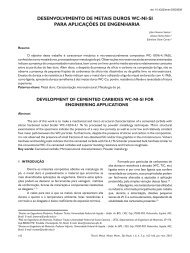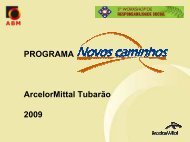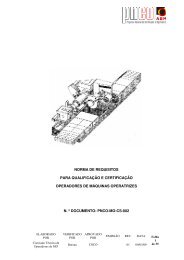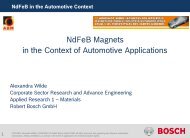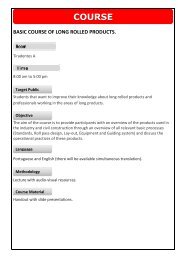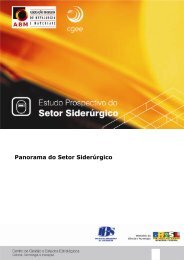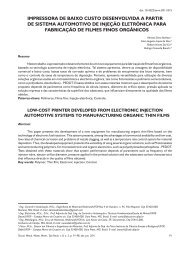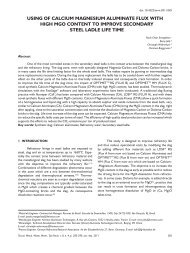Enhanced fully processed electrical steels for automotive ... - ABM
Enhanced fully processed electrical steels for automotive ... - ABM
Enhanced fully processed electrical steels for automotive ... - ABM
Create successful ePaper yourself
Turn your PDF publications into a flip-book with our unique Google optimized e-Paper software.
<strong>Enhanced</strong> <strong>fully</strong> <strong>processed</strong> <strong>electrical</strong> <strong>steels</strong> <strong>for</strong><br />
<strong>automotive</strong> traction applications<br />
Sigrid Jacobs on behalf of the ES team July 2008
Contents<br />
• Introduction to AM in general and specifically Electrical Steels<br />
– People<br />
– Volumes<br />
– Production Units<br />
• General requirements in terms of Electrical Steels of machine per<strong>for</strong>mance<br />
improvements<br />
– Loss reduction<br />
– Flux increase<br />
• ArcelorMittal’s Product Range <strong>for</strong> enhanced machines<br />
– Induction machines<br />
– Synchronous machines<br />
• Technical Support<br />
04/08/2008 Confidential 1
ArcelorMittal: Leader in steel<br />
The world’s only truly global steel maker<br />
No 1 in<br />
North America<br />
77%<br />
Market position and market share estimates by region*<br />
23%<br />
No 1 in<br />
South America<br />
76%<br />
24%<br />
No 1 in<br />
Western Europe<br />
74%<br />
26%<br />
No 1 in Africa<br />
No 1 in Eastern<br />
Europe and CIS<br />
04/08/2008 Confidential 2<br />
53%<br />
Number 1 in 5 regions and 4 continents<br />
A global steel production of 116 million tonnes (2007)<br />
47%<br />
*Source: ArcelorMittal estimates, based on IISI crude steel production<br />
89%<br />
11%<br />
ArcelorMittal<br />
Other
ArcelorMittal in figures*<br />
Sales of US $105.216 billion<br />
EBITDA of US $19.4 billion<br />
Operating income of US $14.83 billion<br />
Net income of US $10.368 billion<br />
Shipment of 109.7 million tonnes<br />
116 million tonnes of steel produced<br />
310,000 employees<br />
in 60 different countries<br />
An integrated leader of the metal and mining sector<br />
04/08/2008 Confidential 3<br />
7%<br />
*2007 pro <strong>for</strong>ma figures<br />
16%<br />
13%<br />
6%<br />
16%<br />
25%<br />
17%<br />
EU15<br />
Rest EU (EU27)<br />
Other European countries<br />
North America<br />
South America<br />
East Asia<br />
Africa
ArcelorMittal: Our identity<br />
We know that our position in the steel industry brings unique responsibilities.<br />
We are committed to setting globally recognized standards with the needs of<br />
future generations in mind.<br />
trans<strong>for</strong>ming tomorrow<br />
ArcelorMittal brand values:<br />
� Sustainability<br />
� Quality<br />
� Leadership<br />
04/08/2008 Confidential 4
ArcelorMittal is committed to<br />
Corporate Responsibility<br />
Signatory to universal guidelines and memberships<br />
• United Nations Global Compact<br />
• United Nations Universal Declaration on Human Rights<br />
• International Labor Organization tripartite core conventions<br />
• World Business Council <strong>for</strong> Sustainable Development (WBCSD)<br />
• Constituent of the FTSE4Good Index Series<br />
Our commitments to trans<strong>for</strong>m tomorrow<br />
04/08/2008 Confidential 5
A three dimensional strategy<br />
ArcelorMittal is the<br />
only producer offering,<br />
leveraging and<br />
developing the full<br />
range of steel products<br />
and services<br />
Product<br />
From commodities to<br />
value added products,<br />
from long products to flat<br />
products, from standard to<br />
speciality products, from<br />
carbon steel to stainless<br />
steel and alloys<br />
Value Chain<br />
ArcelorMittal<br />
ArcelorMittal is not only a steel<br />
producer but an integrated<br />
Metals and Mining leader<br />
capturing opportunities along the<br />
value chain<br />
From mining to distribution,<br />
trans<strong>for</strong>mation and trading of finished<br />
products<br />
Geography<br />
ArcelorMittal is the only<br />
truly global producer<br />
Leadership position in<br />
4 continents and 5 regions<br />
Not only the largest steel producer but a unique Metals & Mining leader<br />
04/08/2008 Confidential 6
AM Hamilton,<br />
Dofasco (CRML)<br />
AM Hennepin<br />
(CRML)<br />
KEY FIGURES 2007 :<br />
ArcelorMittal<br />
Production sites of Electrical Steels<br />
VOLUME : ca. 800kt produced in 9 plants<br />
AM Gent AM Eisenhüttenstadt<br />
AM Florange<br />
AM St.-Chély AM Frýdek Místek (mostly GO)<br />
AM Bilbao<br />
AM Inox Brasil<br />
(also producing GO <strong>steels</strong>)<br />
A WIDE RANGE of GRAIN ORIENTED as well as NON ORIENTED ELECTRICAL STEELS from basic<br />
COLD 04/08/2008 ROLLED over SEMI-PROCESSED Confidential (CRML) to the HIGHEST GRADES of FULLY PROCESSED 7<br />
DEDICATED COMMERCIAL and TECHNICAL ASSISTANCE TEAM
Rotating machines<br />
• Large<br />
– Generators<br />
– Traction<br />
• Medium size<br />
– Industrial motors<br />
– Hermetic Motors (Compressors)<br />
– Automotive traction<br />
• Small<br />
– Household appliances<br />
– Automotive<br />
Market segmentation<br />
Static machines<br />
• Trans<strong>for</strong>mers<br />
– Large Distribution type<br />
– Industrial trans<strong>for</strong>mers and selfs<br />
– Small trans<strong>for</strong>mers<br />
– Ballasts<br />
• Electrical apparatus<br />
– Contactors<br />
– Meters<br />
• Shielding (electro smog)<br />
04/08/2008 Confidential 8
Product groups<br />
ROTATING MACHINES<br />
FULLY<br />
PROCESSED<br />
Supplied with<br />
GUARANTEED<br />
MAGNETIC<br />
PROPERTIES<br />
NON-ORIENTED<br />
isotropic<br />
Produced in most ES PLANTS<br />
SEMI<br />
PROCESSED<br />
Final heat treatment<br />
required <strong>for</strong> DEVELOPING<br />
the GUARANTEED<br />
MAGNETIC PROPERTIES<br />
GRAIN-ORIENTED<br />
anisotropic<br />
Produced in AMIB / AMFM<br />
LARGE TRANSFORMERS<br />
04/08/2008 Confidential 9
Grade designation <strong>for</strong> NO<br />
• IEC, EN:<br />
(JIS, ASTM similar)<br />
M400-50A 5<br />
Gauge mm x 100<br />
= 0.50 mm<br />
IEC <strong>for</strong> 50Hz<br />
Magnetic Steel A = Non-Oriented Fully<br />
Processed grade<br />
Maximum iron losses<br />
K = Non-Oriented Semi-<br />
@1.5T and 50Hz :<br />
Processed grades<br />
x 100<br />
= 4,0 W/kg<br />
04/08/2008 Confidential 10
Global CO2 data<br />
• In the industrialised countries, the transport sector is responsible<br />
<strong>for</strong> about a fifth of CO2 emissions<br />
– ’10 worldwide estimate of the EC: 5461 million t CO2 <strong>for</strong><br />
transport of the global 29055 Mt (source WETO-H2)<br />
• Automobile has a 96% dependence on petroleum so alternatives are<br />
needed not only <strong>for</strong> the environment but also as strategy.<br />
– There are 700 million vehicles on our planet.<br />
– Worldwide 70 million vehicles were sold in ‘07 → 94 million units by<br />
‘16, so by ‘20 15% of the global population will have its own car. In<br />
‘07, 35% of the world energy need comes from petroleum, with est.<br />
2% growth/year.<br />
04/08/2008 Confidential 11
Are biofuels the green solution ?<br />
• EU has set the target of having 10% of overall fuel supply <strong>for</strong> transport in the<br />
<strong>for</strong>m of biofuels by 2020.<br />
• 1st generation biofuels<br />
– are receiving more opposition from green NGOs than any other transport<br />
fuel.<br />
– USA produces 16 million cubic metres annually and Brazil 15<br />
– Production cost of bioethanol: 0.15-0.16 €/l<br />
– 1 l of ethanol is equivalent to 0.671 l of gasoline regarding energy content<br />
– This will reduce petrol dependency<br />
– But is not completely carbon neutral, e.g. Brazil example<br />
• Flash burning the sugar cane fields <strong>for</strong> manual harvest, results in air pollution and<br />
ashes: no longer used<br />
• Mechanised harvest alternative produces GHG and takes away jobs from the very poor<br />
– Other EU dilemma’s: Food or fuel ? Forest or fuel ?<br />
• 2nd generation biofuels<br />
– BiomassToLiquid should overcome most of these problems<br />
– Should be available by 2015<br />
04/08/2008 Confidential 12
New CO2 Regulations<br />
• EU<br />
EU Commission would like to cap average fleet emissions at 130g/km by 2012<br />
Parliament on its side has proposed to reduce them further down to 125g/km (5.2l/100km<br />
in gasoline & 4.7l/100km in diesel) but by 2015.<br />
Legislation framework under discussion : Target may vary depending on Vehicle Mass or<br />
Vehicle Foot Print or both.<br />
Europe’s Council of Ministers will make the final decision this year<br />
• USA<br />
The energy bill signed December 2007 requires automakers to raise the fuel economy of<br />
cars and light trucks by 40% industry wide to 35 mpg by 2020 (from current 27.5mpg <strong>for</strong><br />
cars & 22.2mpg <strong>for</strong> light trucks).<br />
Increases must begin in the 2011 model year. Cars and light trucks, which have current<br />
standards of 27.5 mpg and 22.5 mpg, respectively, will retain separate standards.<br />
Rules <strong>for</strong> each category will be indexed by size and weight.<br />
• Japan<br />
METI has proposed to decrease Passenger car Fuel Consumption by 23.5% between<br />
2004 (7.35l/100km) and 2015 (6.0l/100km)<br />
There is a Rein<strong>for</strong>cement of CO2 legislation in Mature Countries<br />
04/08/2008 Confidential 13
Impact of car weight and fuel type<br />
Source: Global Insight<br />
• 2000 → 2007: average CO2 emissions<br />
<strong>for</strong> all EU25 produced vehicles<br />
– Despite a significant 12% increase in total vehicle mass,<br />
technological advancements have permitted to reduce the<br />
average CO2 emissions to 162g/km in ‘07<br />
– Essential impact was the transition from 30% diesel in ’00 to<br />
50% in ’07<br />
• 2007 → 2012: CO2 <strong>for</strong>ecast based on vehicle types announced<br />
<strong>for</strong> production<br />
– -1% mass <strong>for</strong> diesel and gasoline<br />
– 143g/km CO2 <strong>for</strong> average ’12<br />
production <strong>for</strong>ecast so >130…<br />
04/08/2008 Confidential 14
Petrol consumption and CO2<br />
• Linear relationships have been determined, between gasoline or diesel<br />
consumption and CO2 emissions (mixed cycle). Source: Journal of<br />
chemical education<br />
• 140gCO2/km = 5,8l gasoline or 5,3l diesel /100km<br />
• Reducing to 130gCO2/km requires 7% less fuel consumption<br />
• The hybrid solutions offer this reduction potential<br />
• Ex. BMW series 1: introduction of micro hybrid reduces CO2 from 124<br />
to 115g/km<br />
04/08/2008 Confidential 15
Impact of the first oil crisis in the ’70s<br />
04/08/2008 Confidential 16
Labelling cars<br />
C<br />
G<br />
In application of EU Directive 99/94/EC, Several Countries (Denmark,<br />
NL, BE...) have selected the above <strong>for</strong>mat <strong>for</strong> Car Labelling<br />
04/08/2008 Confidential 17
Fuel Savings Potential of the various<br />
technologies<br />
Fuel Savings Cost Availability Application<br />
Engine Downsizing 5 to 7%
CO2 Reduction Technologies<br />
OEM Program<br />
BMW EfficientDynamics<br />
Stop &<br />
Start<br />
Engine<br />
Downsizing<br />
Mild & Full<br />
Hybrid Fuel Cell<br />
Diesel Hybrid<br />
under Dvlpt<br />
Daimler BlueEfficiency SOP end 08<br />
Fiat (Aria)<br />
Ford ECOnetic<br />
GM ecoFLEX<br />
Honda<br />
Hyundai<br />
Blue Lion<br />
PSA<br />
Airdream<br />
Better Place<br />
Renault eco2<br />
Suzuki<br />
Toyota<br />
VW BLUEMOTION<br />
Mass Prod<br />
by 2012/15<br />
Gas. Hybrid Fuel Cell Fleet<br />
in USA under test<br />
Gas. Hybrid Fuel Cell Fleet<br />
in USA under test<br />
Gas. Hybrid FCX Clarity<br />
in JPN offered in 2008<br />
Mass Prod First model by<br />
by 2009<br />
Diesel Hybrid<br />
under Dvlpt<br />
Work on<br />
Electric<br />
2012<br />
Gas. Hybrid<br />
in JPN<br />
Diesel Hybrid<br />
under Dvlpt<br />
Mass Prod<br />
by 2015<br />
Longer Gear<br />
Ratios<br />
Aerodynamic<br />
Changes<br />
Low Roll<br />
Resistance<br />
Tyres Equipments<br />
Brake Ener.<br />
Recycling<br />
Better Ener.<br />
Management<br />
Source : Press Releases<br />
Most of OEMs have programs designed to experiment fuel saving<br />
technologies <strong>for</strong> mass market:<br />
Stop & Start, Gear Ratios, Aerodynamic Changes, Green Tyres<br />
04/08/2008 Confidential 19<br />
Weight<br />
Reduction<br />
Lighter<br />
materials
Hybridisation technologies and markets<br />
• Europe’s high efficiency diesel history requires a different hybrid<br />
solution than the US and Japan<br />
04/08/2008 Confidential 20
Overview: hybrid systems<br />
- starter (DC-machine; 1-2.5 kW) starts ICE<br />
- generator (Lundell, clawpole-alternator;<br />
1-3kW) power supply <strong>for</strong> <strong>electrical</strong><br />
equipment, charges battery<br />
- starter-generator combines starting and<br />
power supply operation (2-3 kW)<br />
- functionality:<br />
- fast start/stop of ICE<br />
- generator operation<br />
- <strong>electrical</strong> machine (10-15 kW) integrated in<br />
the drivetrain<br />
- functionality<br />
- start/stop<br />
- generator operation<br />
- boost operation<br />
- recuperation<br />
04/08/2008 Confidential 21
Overview: hybrid systems<br />
- ICE in optimal operating point<br />
- several trans<strong>for</strong>mations of energy<br />
� lower overall efficiency<br />
- drive without ICE is possible<br />
� „zero emission“<br />
- good weight arrangement is possible,<br />
due to separate arrangement of the<br />
machines and the engine<br />
- ICE mechanically connected to the wheels (� gear)<br />
- less trans<strong>for</strong>mations of energy<br />
� better overall efficiency than series system<br />
- four operating points available:<br />
- <strong>electrical</strong> traction<br />
- ICE-traction<br />
- ICE-traction + charging of battery<br />
- <strong>electrical</strong>- and ICE-traction („boost” at peak load)<br />
- continuous combination of series and parallel<br />
hybrid system<br />
� overall efficiency like parallel hybrid system<br />
- “down-sizing” is possible<br />
� less frictional losses<br />
� better overall efficiency<br />
04/08/2008 Confidential 22
Electrical Steels in Automotive Drive Systems<br />
• Standard solution: Start motor + Alternator<br />
starter alternator<br />
alternator stator laminations<br />
• Higher efficiency: Starter-Alternator featuring Start/Stop<br />
04/08/2008 Confidential 23<br />
stator laminations of higher per<strong>for</strong>mance ES
Electrical Steels in Automotive Drive Systems<br />
• Further efficiency increase: hybrid traction<br />
04/08/2008 Confidential 24<br />
Orion VII diesel-electric hybrid transit bus<br />
internal<br />
combustion<br />
engine and<br />
e-machine<br />
battery
Overview: typically used machines<br />
ASM SRM PMSM / BLDC<br />
motor converter motor converter motor converter<br />
efficiency + - - / 0 0 + +<br />
reliability + 0 -<br />
power density - - 0 0 + +<br />
torque ripple + - 0<br />
overload capicity + - / 0 0<br />
size - 0 / + +<br />
cost + - 0 0 / + - 0 / +<br />
max. revolution 0 + -<br />
controler complexity<br />
IEEE AES Systems Magazine<br />
- / 0 + - / 0<br />
DC ASM PMSM SRM<br />
max. efficiency (%) 85-89 94-95 95-97 90<br />
efficiency (load 10%) (%) 80-87 79-85 90-92 78-86<br />
max. revolution (rpm) 4000-6000 9000-15000 4000-10000 15000<br />
cost/torque ($/kW) 10 8-12 10-15 6-10<br />
cost of controller 1 3.5 2.5 4.5<br />
reliability good best good good<br />
Nippon Steel Technical Report<br />
DC ASM PMSM SRM<br />
power density 2,5 3,5 5 3,5<br />
efficiency 2,5 3,5 5 3,5<br />
controllability 5 5 4 3<br />
reliability 3 5 4 5<br />
technolocical maturity 5 5 4 4<br />
cost 4 5 3 4<br />
examples of<br />
several evaluations<br />
- some differences<br />
- distinctive similarities<br />
points: 1 – 5<br />
(ascending better)<br />
IEEE Transactions on Vehicular Technology<br />
04/08/2008 Confidential 25
Our hybrid offer today<br />
Micro Hybrid<br />
• Stop/Start<br />
• -5% energy/CO2<br />
•
Non-Oriented<br />
Fully Processed Electrical Steel range<br />
Thickness 0.35mm or 0.0140inch 0.50mm or 0.0185inch 0.65mm or 0.0250inch 1.00mm<br />
ASTM<br />
denisity<br />
IEC 60404-8-4 ASTM A677 IEC 60404-8-4 ASTM A677 IEC 60404-8-4 ASTM A677 IEC 60404-8-4<br />
M195-35A*<br />
M210-35A<br />
M235-35A 5 M230-50A 5<br />
M250-35A 5 36F145 (M15) M250-50A 5<br />
M270-35A 5 36F155 (M19) M270-50A 5<br />
M300-35A 5 36F165 (M22) M290-50A 5 47F165 (M19)<br />
36F175 (M27) M310-50A 5 47F180 (M22) M310-65A 5<br />
M330-35A 5* 36F185 (M36) M330-50A 5* 47F190 (M27) M330-65A 5 64F200 (M19)<br />
36F195 (M43) M350-50A 5* 47F200 (M36) M350-65A 5 64F210 (M22)<br />
36F205 (M45) M400-50A 5* 47F210 (M43) M400-65A 5 64F235 (M36)<br />
M470-50A 5 47F240 (M45) M470-65A 5* 64F250 (M43)<br />
M530-50A 5 47F280 (M47) M530-65A 5 64F275 (M45)<br />
M600-50A 5 M600-65A 5 64F320 (M47) M600-100A 5<br />
M700-50A 5 47F400 M700-65A 5 M700-100A 5<br />
M800-50A 5 47F450 M800-65A 5 M800-100A 5<br />
M940-50A 5 64F500 M900-100A 5<br />
M1000-65A 5 64F550 M1000-100A 5<br />
M1300-100A 5<br />
• Correspond with: EN 10106, JIS C 2552, GB/T 2521, ASTM A 677<br />
• Grades marked with * exist also in extra high permeability version<br />
• Grades marked in italic are not included in the standard<br />
• Other Fully Processed grades available on request (e.g. 0,30mm)<br />
04/08/2008 Confidential 27
Other AM Electrical Steels<br />
Non-Oriented<br />
• Thin Fully Processed grades <strong>for</strong> medium frequencies (IEC 60404-8-8)<br />
– 0,20 mm thickness<br />
• Fully Processed grades with increased yield strength (AM guarantee)<br />
– 0,50 and 0,65mm thickness<br />
• Semi-Processed grades non-alloyed and alloyed (IEC 60404-8-3)<br />
– Exist also in extra high perm version (AM guarantee)<br />
• Cold-Rolled Magnetic Laminations (no IEC, ASTM A 726)<br />
• Steel with specified mechanical properties and magnetic permeability<br />
(IEC 60404-8-5)<br />
– Hot-Rolled and Cold-Rolled versions<br />
• Steel with guaranteed punchability (AM guarantee)<br />
Grain-Oriented<br />
• Conventional Fully Processed grades (IEC 60404-8-7)<br />
04/08/2008 Confidential 28
Core<br />
Loss<br />
Product Segmentation - NO<br />
ArcelorMittal Group focus on the High and Ultra High Grades used in energy<br />
efficient machines.<br />
High Core<br />
Loss<br />
Ultra low<br />
Core Loss<br />
Low<br />
Grade<br />
M940 - 50A<br />
M800 – 50A<br />
M700 – 50A<br />
M600 – 50A<br />
Medium<br />
Grade<br />
M530 – 50A<br />
M470 – 50A<br />
M400 – 50A<br />
High<br />
Grade<br />
M350 – 50A<br />
M330 – 50A<br />
M310 – 50A<br />
Ultra High<br />
Grade<br />
M290 – 50A<br />
M270 – 50A<br />
M250 – 50A<br />
M230 – 50A<br />
04/08/2008 Confidential 29
Electro-magnetic flux generation<br />
Magnetic field<br />
(A/m)<br />
i<br />
Magnetic flux<br />
Φ = B.S<br />
Stack of<br />
Electrical Steel<br />
sheets<br />
B5000 (T)<br />
Principal role of <strong>electrical</strong><br />
<strong>steels</strong>: to generate /<br />
concentrate magnetic<br />
flux<br />
Induction<br />
- For torque generation in a<br />
motor<br />
- For current generation in an<br />
alternator / generator<br />
- For trans<strong>for</strong>ming electric<br />
power to a lower/higher<br />
voltage level in a trans<strong>for</strong>mer<br />
with minimal losses<br />
- Since losses imply efficiency<br />
reduction and thermal issues<br />
04/08/2008 Confidential 30<br />
5000 A/m<br />
Magnetic<br />
field
The basics: Losses<br />
P =<br />
P + P + P = W π σ<br />
+ σ<br />
hyst<br />
class<br />
exc<br />
(Giorgio Bertotti, IEEE Trans. Magn. 24, 621, 1988)<br />
• The material parameters Wh and V0 are a function of Imax and<br />
are defined by the material’s microstructure and texture, so<br />
through them the steel producer has an impact on the hysteresis<br />
(hyst) and the excess (exc) losses.<br />
• The <strong>electrical</strong> conductivity σ and the lamination thickness d are<br />
the parameter set the steel producer can change <strong>for</strong> reducing<br />
the eddy current, Foucault or classical losses (class).<br />
• Finally in this equation: G = 0,1357.<br />
2 2 2 2<br />
h ( I max ) f + d I max f m / 6 8 GSV0<br />
( I max f m<br />
04/08/2008 Confidential 31<br />
)<br />
3 2
Measures taken by the steel producers to<br />
reduce the hysteresis impact<br />
Domain wall mobility<br />
# DWs<br />
Reduce impurities<br />
Larger Grains<br />
Easier magnetisation Improved Texture<br />
04/08/2008 Confidential 32
Measures taken by the steel producers to<br />
reduce the eddy current impact<br />
Resistivity<br />
Gauge<br />
Fe-Si<br />
Laminations<br />
Insulation between sheets<br />
Varnish, oxydes<br />
04/08/2008 Confidential 33
The basics: Losses<br />
P =<br />
P + P + P = W π σ<br />
+ σ<br />
hyst<br />
class<br />
exc<br />
(Giorgio Bertotti, IEEE Trans. Magn. 24, 621, 1988)<br />
• For low frequency applications, the relative importance of<br />
hysteresis losses is predominant, so optimisation concerns<br />
essentially the steel microstructure and texture<br />
– EN10106 describes 50Hz FP grades<br />
• For high frequency applications, the relative importance of eddy<br />
current losses is predominant, so optimisation concerns the<br />
steel resistivity, thickness and microstructure<br />
– EN10303 describes 400Hz FP grades<br />
2 2 2 2<br />
h ( I max ) f + d I max f m / 6 8 GSV0<br />
( I max f m<br />
→ ArcelorMittal has developed specific loss combinations <strong>for</strong><br />
specific frequency ranges, down to very low losses<br />
04/08/2008 Confidential 34<br />
)<br />
3 2
Hybridisation: machines → steel grades<br />
• Hybridisation utilises specific <strong>electrical</strong> machines, translating to<br />
specific <strong>electrical</strong> steel demands<br />
• The following slides show how ArcelorMittal’s offer includes the<br />
appropriate materials<br />
• For each machine type, we can offer the most suited grade<br />
04/08/2008 Confidential 35
Machine challenge<br />
Starter-Generator<br />
• Machine requirements<br />
(Integrated or belt driven type<br />
determines a.o. rotational<br />
speed)<br />
– Optimal efficiency at a wide<br />
frequency range<br />
– Minimal heat dissipation<br />
– Maximal specific power<br />
– Electrical machine design<br />
optimised together with power<br />
electronics<br />
• Machine types<br />
– Claw-pole (essentially EU)<br />
– Induction (essentially EU)<br />
– Permanent Magnet (essentially<br />
JP)<br />
Motor Generator<br />
• Machine requirements<br />
– Optimal efficiency at a wide<br />
frequency range<br />
– Maximal torque / power<br />
– Maximal specific power<br />
– Minimal weight / volume<br />
(specificity of wheel hub<br />
motors)<br />
• Machine types<br />
– Induction (essentially EU)<br />
– Permanent Magnet (essentially<br />
JP)<br />
04/08/2008 Confidential 36
Some specific steel solutions<br />
Claw-pole and induction machines<br />
High Permeability – High Thermal Conductivity Fully Processed<br />
grades with medium loss levels<br />
• At moderate polarisation levels, higher efficiency achieved<br />
• Higher saturation polarisation permits better material use<br />
• Easier heat evacuation<br />
• Higher tool life in punching process<br />
• (very thin grades bring no substantial benefit to claw-pole<br />
machines)<br />
04/08/2008 Confidential 37
Example: M400-50A 5<br />
(47F210 or M43)<br />
Magnetic advantage of high<br />
perm grades<br />
• Same air gap flux with lower<br />
magnetising current<br />
• Better saturation behaviour<br />
• Thermal Conductivity<br />
increased with 22%<br />
• For similar loss levels<br />
Especially beneficial at low<br />
frequencies<br />
04/08/2008 Confidential 38<br />
J<br />
Polarisation magnétique ( Tesla )<br />
2,1<br />
2,0<br />
1,9<br />
1,8<br />
1,7<br />
1,6<br />
1,5<br />
1,4<br />
1,3<br />
1,2<br />
1,1<br />
1,0<br />
0,9<br />
0,8<br />
0,7<br />
0,6<br />
0,5<br />
0,4<br />
0,3<br />
0,2<br />
0,1<br />
à 50 Hz<br />
400XP - 50<br />
400 - 50<br />
0,0<br />
10 100 1000 10000<br />
Champ magnétique ( A/m )<br />
H
J<br />
Magnetic polarisation ( Tesla )<br />
2,1<br />
2,0<br />
1,9<br />
1,8<br />
1,7<br />
1,6<br />
1,5<br />
1,4<br />
1,3<br />
1,2<br />
1,1<br />
1,0<br />
0,9<br />
0,8<br />
0,7<br />
0,6<br />
0,5<br />
0,4<br />
0,3<br />
0,2<br />
0,1<br />
Example: M400-50A 5 (47F210 or M43)<br />
perm @ 1,5T (specs US: 800-1750)<br />
Y<br />
XP version Ref. J 76565 N<br />
standard version<br />
2,1<br />
µr<br />
J 50 Hz 1,9<br />
J 60 Hz<br />
1,7<br />
µr<br />
04/08/2008 Confidential 39<br />
0,0<br />
0,0<br />
10 100 1000 10000<br />
Magnetic field ( A/m )<br />
Y<br />
7000<br />
6000<br />
5000<br />
4000<br />
3000<br />
2000<br />
1000<br />
H<br />
µr<br />
J<br />
Magnetic polarisation ( Tesla )<br />
2,0<br />
1,8<br />
1,6<br />
1,5<br />
1,4<br />
1,3<br />
1,2<br />
1,1<br />
1,0<br />
0,9<br />
0,8<br />
0,7<br />
0,6<br />
0,5<br />
0,4<br />
0,3<br />
0,2<br />
0,1<br />
Ref. T 38727<br />
7000<br />
6000<br />
5000<br />
4000<br />
3000<br />
2000<br />
1000<br />
10 100 1000 10000<br />
Magnetic field ( A/m )<br />
µr<br />
H<br />
J 50 Hz<br />
µr<br />
J 60 Hz<br />
µr
Texture<br />
improvement<br />
methods:<br />
Special alloy<br />
& thermal<br />
treatment<br />
PHI<br />
PHI<br />
0<br />
10<br />
20<br />
30<br />
40<br />
50<br />
60<br />
70<br />
0<br />
1.00<br />
0<br />
2.0<br />
1.00<br />
5.0<br />
2.0<br />
3.0<br />
0<br />
3.0<br />
0<br />
10.0<br />
3.0 2.0<br />
9.0<br />
6.0 4.0<br />
8.0<br />
7.0<br />
3.0<br />
2.0<br />
0<br />
1.00<br />
0<br />
4.0<br />
0<br />
6.0<br />
04/08/2008 0 10 20 30 Confidential 40 50 60 70 80 90<br />
40<br />
1.00<br />
5.0<br />
7.0 9.0<br />
80<br />
1.00<br />
0<br />
90<br />
0 10 20 30 40 50 60 70 80 90<br />
0<br />
10<br />
20<br />
30<br />
40<br />
50<br />
60<br />
70<br />
80<br />
90<br />
1.0<br />
1.0<br />
2.0<br />
0<br />
Constante Phi2 = 45°<br />
7.0<br />
1.0<br />
3.0<br />
+thermal<br />
treatment<br />
Phi1<br />
Constante Phi2 = 45°<br />
4.0 2.0<br />
6.0<br />
3.0<br />
0<br />
1.0<br />
2.0<br />
1.0<br />
0<br />
2.0<br />
1.0<br />
5.0 3.0 6.0<br />
Phi1<br />
Special alloy<br />
PHI<br />
Special alloy+treatment<br />
0<br />
5.0<br />
4.0<br />
4.0<br />
Special alloy<br />
PHI<br />
0<br />
10<br />
20<br />
30<br />
0<br />
10<br />
20<br />
30<br />
40<br />
50<br />
60<br />
70<br />
1.0<br />
0<br />
1.0<br />
4.0<br />
4.0<br />
Constante Phi2 = 45°<br />
Constante Phi2 = 45°<br />
4.0<br />
2.0<br />
3.0<br />
1.0<br />
3.0<br />
0<br />
0<br />
1.0<br />
2.0<br />
3.0<br />
2.0<br />
2.0<br />
1.0<br />
2.0<br />
1.0<br />
80<br />
90<br />
2.0<br />
0<br />
1.0 2.0<br />
0 10 20 30 40 50 60 70 80 90<br />
0<br />
Phi1<br />
3.0<br />
2.0<br />
1.0<br />
40<br />
0<br />
1.0<br />
3.0<br />
50<br />
60<br />
2.0 6.0<br />
2.0<br />
5.0<br />
3.0<br />
4.0<br />
2.0<br />
5.0<br />
70<br />
1.0<br />
0 0<br />
80 1.0<br />
90<br />
0<br />
1.0<br />
0<br />
0 10 20 30 40 50 60 70 80 90<br />
+thermal<br />
treatment<br />
Phi1<br />
0<br />
0
Thermal treatment improvement ex.:<br />
5,000<br />
Hot Band Annealing<br />
• The reduction obtained<br />
on the total loss level<br />
via HBA is clearly due<br />
to a reduction in<br />
hysteresis losses<br />
1,6<br />
1,2<br />
0,8<br />
0,4<br />
0<br />
-500 -400 -300 -200 -100 0 100 200 300 400 500<br />
-0,4<br />
-0,8<br />
04/08/2008 -1,2 Confidential 41<br />
-1,6<br />
no HBA<br />
Ptot (W/kg)<br />
4,500<br />
4,000<br />
3,500<br />
3,000<br />
2,500<br />
2,000<br />
1,500<br />
1,000<br />
0,500<br />
Hot Band Annealed<br />
Ptot, Hot Band Annealed<br />
Ptot, no HBA<br />
Physt, Hot Band Annealed<br />
Physt, no HBA<br />
Bp (T)<br />
0,000<br />
0,000 0,200 0,400 0,600 0,800 1,000 1,200 1,400 1,600 1,800<br />
• The impact of HBA on the<br />
hysteresis loop shape is most<br />
prominent around the<br />
deflection point, which reflects<br />
the impact of texture<br />
=> The magnetisation loop is<br />
steeper
Thermal Conductivity<br />
• Replacing alloying by other product improvement elements,<br />
allows improving the heat evacuation ease out of the machine<br />
κ = α p C<br />
Thermal Conductivity (W/mK)<br />
50<br />
45<br />
40<br />
35<br />
30<br />
25<br />
20<br />
Thermal conductivity κ (W/mK) determined via:<br />
δ<br />
Diffusivity a (mm²/s): Laser Flash = Transient method.<br />
Density d (g/cm³): Double Weight test (picnometer).<br />
Specific heat Capacity Cp (J/gK): Differential Scanning Calorimetry (DSC).<br />
M400XP-50A<br />
M400-50A<br />
0.00 0.50 1.00 1.50 2.00<br />
Si + Al (%)<br />
2.50 3.00 3.50 4.00<br />
162 °C<br />
124 °C<br />
04/08/2008 Confidential 42<br />
85 °C<br />
50 °C
W<br />
Specific losses ( W/kg )<br />
1000,000<br />
100,000<br />
10,000<br />
Summary: overview of production parameter impact<br />
Example: M235-35A 5<br />
1,000<br />
0,100<br />
0,010<br />
Improve hysteresis, eddy currents, excess:<br />
Texture, Structure, Chemistry, Stresses,<br />
Surface state<br />
04/08/2008 Confidential 43<br />
0,001<br />
0,0 0,2 0,4 0,6 0,8 1,0 1,2 1,4 1,6 1,8<br />
Magnetic polarisation ( Tesla )<br />
Ref. F 82631 N<br />
700 Hz<br />
400 Hz<br />
200 Hz<br />
100 Hz<br />
60 Hz<br />
50 Hz<br />
J<br />
J<br />
Magnetic polarisation ( Tesla )<br />
2,1<br />
2,0<br />
1,9<br />
1,8<br />
1,7<br />
1,6<br />
1,5<br />
1,4<br />
1,3<br />
1,2<br />
1,1<br />
1,0<br />
0,9<br />
0,8<br />
0,7<br />
0,6<br />
0,5<br />
0,4<br />
0,3<br />
0,2<br />
0,1<br />
50 Hz<br />
60 Hz<br />
100 Hz<br />
200 Hz<br />
400 Hz<br />
700 Hz<br />
Texture improvement:<br />
Thermo-mechanical process<br />
Chemical composition<br />
Facilitate domain wall movement:<br />
Chemistry purification<br />
Internal tension reduction<br />
Increasing grain size<br />
0,0<br />
10 100 1000 10000<br />
Magnetic field ( A/m )<br />
Chemical composition:<br />
Reduce Si, Al<br />
Ref. F 82631 N<br />
H
Compromises to be made<br />
• Si increases the resistivity,<br />
so reduces the eddy current losses,<br />
but in parallel reduces the saturation level<br />
• Larger grains reduce the hysteresis losses,<br />
but soften the mechanical properties<br />
⇒ Specific grades are needed <strong>for</strong> specific applications<br />
04/08/2008 Confidential 44
Machine challenge<br />
Starter-Generator<br />
• Machine requirements<br />
(Integrated or belt driven type<br />
determines a.o. rotational<br />
speed)<br />
– Optimal efficiency at a wide<br />
frequency range<br />
– Minimal heat dissipation<br />
– Maximal specific power<br />
– Electrical machine design<br />
optimised together with power<br />
electronics<br />
• Machine types<br />
– Claw-pole (essentially EU)<br />
– Induction (essentially EU)<br />
– Permanent Magnet (essentially<br />
JP)<br />
Motor Generator<br />
• Machine requirements<br />
– Optimal efficiency at a wide<br />
frequency range<br />
– Maximal torque / power<br />
– Maximal specific power<br />
– Minimal weight / volume<br />
(specificity of wheel hub<br />
motors)<br />
• Machine types<br />
– Induction (essentially EU)<br />
– Permanent Magnet (essentially<br />
JP)<br />
04/08/2008 Confidential 45
Wheel-hub motors<br />
Technology<br />
• Brushless AC PM motor<br />
• With gearbox: <strong>for</strong> high speed, but rotor speed → iron losses → cooling<br />
• Without gearbox: <strong>for</strong> direct drive → low speed, higher torque<br />
• Lowest loss FeSi <strong>steels</strong> used in 0,35mm or less, higher saturation is beneficial<br />
04/08/2008 Confidential 46
Some specific steel solutions<br />
Permanent magnet machines<br />
Low loss Fully Processed grades<br />
• Reduced losses at higher frequencies and in presence of harmonics,<br />
bringing minimal heat dissipation<br />
• Thin materials <strong>for</strong> eddy currents reduction and skin effect minimisation<br />
– NO20 grade is designed <strong>for</strong> 400Hz applications<br />
– Non standardised thicknesses such as 0,3mm<br />
• Low coercive fields<br />
• For specific rotor geometries, higher permeability, additionally to the<br />
low losses, can present an advantage<br />
• Higher yield strength grades <strong>for</strong> higher rotational speeds<br />
– 70MPa Re variation <strong>for</strong> a given steel grade is easily possible,<br />
depending on the chosen production process<br />
• Optimised coatings <strong>for</strong> maximising tool life in punching process<br />
– Typically, applying an EC-5 or EC-6 coating reduces the wear with<br />
80-85%; an EC-3 with 92%<br />
04/08/2008 Confidential 47<br />
– Cr-free solution <strong>for</strong> EU regulations
W<br />
Specific losses ( W/kg )<br />
1000,000<br />
100,000<br />
10,000<br />
Example: M235-35A 5<br />
(better than 36F145 or M15)<br />
1,000<br />
0,100<br />
0,010<br />
Improve hysteresis, eddy currents, excess:<br />
Texture, Structure, Chemistry, Stresses,<br />
Surface state<br />
04/08/2008 Confidential 48<br />
0,001<br />
0,0 0,2 0,4 0,6 0,8 1,0 1,2 1,4 1,6 1,8<br />
Magnetic polarisation ( Tesla )<br />
Ref. F 82631 N<br />
700 Hz<br />
400 Hz<br />
200 Hz<br />
100 Hz<br />
60 Hz<br />
50 Hz<br />
J<br />
J<br />
Magnetic polarisation ( Tesla )<br />
2,1<br />
2,0<br />
1,9<br />
1,8<br />
1,7<br />
1,6<br />
1,5<br />
1,4<br />
1,3<br />
1,2<br />
1,1<br />
1,0<br />
0,9<br />
0,8<br />
0,7<br />
0,6<br />
0,5<br />
0,4<br />
0,3<br />
0,2<br />
0,1<br />
50 Hz<br />
60 Hz<br />
100 Hz<br />
200 Hz<br />
400 Hz<br />
700 Hz<br />
Texture improvement:<br />
Thermo-mechanical process<br />
Chemical composition<br />
Facilitate domain wall movement:<br />
Chemistry purification<br />
Internal tension reduction<br />
Increasing grain size<br />
0,0<br />
10 100 1000 10000<br />
Magnetic field ( A/m )<br />
Chemical composition:<br />
Reduce Si, Al<br />
Ref. F 82631 N<br />
H
W<br />
Specific losses ( W/kg )<br />
Example: M195P-35A 5<br />
1000,000<br />
100,000<br />
10,000<br />
1,000<br />
0,100<br />
0,010<br />
04/08/2008 Confidential 49<br />
0,001<br />
0,0 0,2 0,4 0,6 0,8 1,0 1,2 1,4 1,6 1,8<br />
Magnetic polarisation ( Tesla )<br />
Grade: M 195 - 35 A<br />
Typical curves W ( J )<br />
Ref. BRMOY12 I<br />
2500 Hz<br />
1500 Hz<br />
1000 Hz<br />
700 Hz<br />
400 Hz<br />
200 Hz<br />
100 Hz<br />
60 Hz<br />
50 Hz<br />
J<br />
J<br />
Magnetic polarisation ( Tesla )<br />
2,1<br />
2,0<br />
1,9<br />
1,8<br />
1,7<br />
1,6<br />
1,5<br />
1,4<br />
1,3<br />
1,2<br />
1,1<br />
1,0<br />
0,9<br />
0,8<br />
0,7<br />
0,6<br />
0,5<br />
0,4<br />
0,3<br />
0,2<br />
0,1<br />
50 Hz<br />
60 Hz<br />
100 Hz<br />
200 Hz<br />
400 Hz<br />
700 Hz<br />
1000 Hz<br />
1500 Hz<br />
2500 Hz<br />
0,0<br />
10 100 1000 10000<br />
Magnetic field ( A/m )<br />
Grade: M 195 - 35 A<br />
Typical curves J ( H )<br />
Ref. BRMOY12 I<br />
H
Non-Oriented<br />
Fully Processed Electrical Steel range (IEC 60404-8-4)<br />
Thickness (mm) 0.35<br />
M195-35A 5*<br />
ASTM denisity<br />
M210-35A 5<br />
0.50 0.65 1.00<br />
M235-35A 5 M230-50A 5<br />
M250-35A 5 M250-50A 5<br />
M270-35A 5 M270-50A 5<br />
M300-35A 5 M290-50A 5<br />
M310-50A 5 M310-65A 5<br />
M330-35A 5* M330-50A 5* M330-65A 5<br />
M350-50A 5* M350-65A 5<br />
M400-50A 5* M400-65A 5<br />
M470-50A 5 M470-65A 5*<br />
M530-50A 5 M530-65A 5<br />
M600-50A 5 M600-65A 5 M600-100A 5<br />
M700-50A 5 M700-65A 5 M700-100A 5<br />
M800-50A 5 M800-65A 5 M800-100A 5<br />
M940-50A 5 M900-100A 5<br />
M1000-65A 5 M1000-100A 5<br />
M1300-100A 5<br />
• Correspond with: EN 10106, JIS C 2552, GB/T 2521, ASTM A 677<br />
• Grades marked with * exist also in extra high permeability version<br />
• Grades marked in italic are not included in the standard<br />
• Other Fully Processed grades available on request (e.g. 0,30mm)<br />
04/08/2008 Confidential 50
ArcelorMittal can offer you a wide range<br />
of magnetic materials<br />
Electrical Steels<br />
• The heart of an <strong>electrical</strong> motor<br />
or generator<br />
• Determining to a large extent the<br />
per<strong>for</strong>mance of these machines<br />
– Power output<br />
– Efficiency<br />
– Power density<br />
– Heat dissipation<br />
Contact<br />
sigrid.jacobs@arcelormittal.com<br />
www.arcelormittal.com/fcs (not a<br />
global catalogue yet, but technical in<strong>for</strong>mation<br />
on all AM products can be easily discussed)<br />
Special alloys FeNi FeCo<br />
• For outstanding per<strong>for</strong>mance of<br />
sensors and actuators<br />
– Sensitivity<br />
– Reliability<br />
• Linked with specific application<br />
demands<br />
– Dynamic behaviour<br />
– High Power density<br />
– High temperature<br />
– Corrosion<br />
Contact<br />
herve.fraisse@arcelormittal.com<br />
www.imphyalloys.com<br />
04/08/2008 Confidential 51
ArcelorMittal<br />
Main R&D Centers <strong>for</strong> Electrical Steels<br />
AM Timóteo<br />
AM Gent<br />
04/08/2008 Confidential 52
AM Electrical Steel Research Centres<br />
• Product development and optimisation<br />
– Pilot lines <strong>for</strong> small scale ES<br />
substrate and coating production<br />
– Modelling tools <strong>for</strong> steering<br />
production processes<br />
– Texture control (XRD, EBSD)<br />
– Precipitate control (SEM, TEM,<br />
quantification methods)<br />
– Chemical composition (spectro,<br />
combustion, GDOES, XPS, Auger)<br />
04/08/2008 Confidential 53<br />
Precipitated Mass Fraction (ppm)<br />
50<br />
40<br />
30<br />
20<br />
10<br />
0<br />
500<br />
600<br />
700<br />
800<br />
900<br />
1000<br />
Temperature (°C)<br />
TiN TiS Ti4C2S2 MnS<br />
TiC AlN NbC VC<br />
1100<br />
1200<br />
1300<br />
1400
AM Electrical Steel Research Centres<br />
• Production support<br />
– Magnetic measurements<br />
• In-line: process control<br />
• Off-line: advanced characterisation<br />
– Mechanical measurements<br />
• Tensile tests under low – high<br />
temperatures<br />
• Fatigue<br />
– Coating systems<br />
• Curing control<br />
• Mechanical property development<br />
– Electrical Conductivity<br />
• Coating<br />
• Steel low-high temperatures<br />
– Thermal Conductivity<br />
3rd and 5th harmonic<br />
04/08/2008 Confidential 54<br />
2D
AM Electrical Steel Research Centres<br />
• Customer Technical Support<br />
– Modelling tools<br />
• FEM machine modelling<br />
• Annealing process modelling <strong>for</strong><br />
Semi-Processed products<br />
– Punching expertise<br />
– Sample characterisation <strong>for</strong><br />
process optimisation<br />
• Welding<br />
• De<strong>for</strong>mation<br />
Punch<br />
streamer<br />
Planishing<br />
machine<br />
Feeder &<br />
Lubrification<br />
60 T PRESS<br />
04/08/2008 Confidential 55<br />
Edge<br />
rounding<br />
Front<br />
face<br />
wear<br />
Lateral<br />
wear<br />
Tool
AM can provide you with Electrical Steels<br />
• For the e-machines required <strong>for</strong><br />
– On-board electricity provision<br />
– Traction assistance / pure electric traction<br />
– Additional safety / com<strong>for</strong>t features<br />
• With a wide range of <strong>electrical</strong> steel types including the highest<br />
per<strong>for</strong>mance types<br />
– Excellent compromise of higher permeability, higher thermal<br />
conductivity at medium loss levels <strong>for</strong> Induction Machines<br />
– Lower loss dissipation and Improved high frequency<br />
behaviour via thin low loss grades <strong>for</strong> Permanent Magnet<br />
Machines<br />
04/08/2008 Confidential 56
Conclusions<br />
• By ’12 CO2 needs to reduce from an average 162 to 130g/km in EU, which is<br />
another 20%<br />
• Hybridisation of the traction drive train is one of the unavoidable steps to get<br />
there, if we are not prepared to switch to smaller, less sporty cars<br />
• ArcelorMittal is ready to supply a wide product<br />
range<br />
• We assist you with a highly skilled team <strong>for</strong><br />
technical support and co-engineering<br />
• Thanks to our global presence we are able to<br />
support our global customers<br />
04/08/2008 Confidential 57



